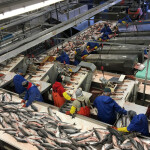When Great Atlantic Shellfish hired Ruth Levy to be a purchasing agent in 1981, the Long Island company employed her through a minority grant. Levy was designated as such because she is a woman.
“A woman was considered a minority. I was certainly a minority on the waterfront,” remembers Levy, who 30 years later is the chief business development officer of Stavis Seafoods in Boston. “There were no women fishing; there were very few women in the industry at that time.”
Times have changed, albeit slowly. Only 10 years ago those attending the International Boston Seafood Show recall just a handful of women among the crowd. Perhaps most noticeable were the ones in bikinis or fishnet stockings that some exhibitors hired each year to attract the mostly male attendees. Now there are more women both on the trade show floor (fully clothed) and throughout the seafood industry. Female leaders like Levy have taken on prominent roles.
Women’s roles in the industry have progressed, yet they still face challenges. Seafood’s reputation for being male-dominated lingers, women in upper management remain a minority and the globalization of seafood means sometimes doing business with countries where women are discriminated against because of their gender.
Women play significant roles in the small-scale and industrial fisheries around the world, most often in processing and marketing, according to the Food and Agriculture Organization. In India, young women make up 60 percent of the workforce in fish-processing factories, while in Vietnam 80 percent of aquaculture workers are female. But low value is often attached to women’s work in some developing countries.
“Despite their crucial contributions to the fisheries industry and to household livelihoods and nutrition, these women are often invisible to policy makers who have traditionally assumed — mistakenly — that fisheries are a male domain,” wrote Jennie Dey de Pryck in an FAO draft report on “Good practice policies to eliminate gender inequalities in fisheries value chains.” Women make up about half of the 200 million people working in the seafood industry worldwide, according to the 2012 report.
Click here to read the full story, which ran in the August issue of SeaFood Business >





